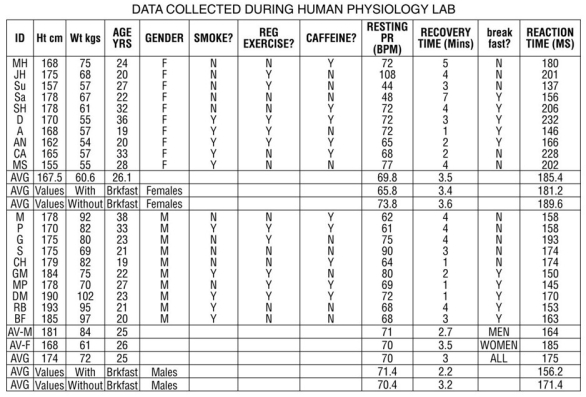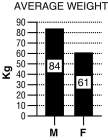Following is a table of data collected from one section of an 8 a.m.physiology lab.There were 20 students present, 10 men and 10 women.Information collected from the students included their height, weight, age, gender, and resting pulse rate.In addition, the students were surveyed to see if they smoked cigarettes, considered themselves "regular exercisers," if they had consumed caffeine the morning of the lab, and if they had eaten breakfast that day.A "y" or "n" (yes or no) was recorded to indicate their answers.Each student did "jumping jacks" for 5 minutes and recorded the time required to regain their resting heart rate, which is listed on the table as "recovery time." Finally, each student participated in an exercise designed to measure their reaction time (in milliseconds) in catching an object dropped by a lab partner according to specified criteria.Use this table to answer the following questions.Ignore statistical problems caused by small sample size, and so on.

Table 1.3

Figure 1.3
For these questions, the data were separated and analyzed by gender.
-Refer to Table 1.3.
A.Disregarding gender, write a hypothesis that expresses the relationship between weight and height.
B.What is the dependent variable? What is the independent variable?
C.From the data in Table 1.3, construct a graph that examines this relationship.
Definitions:
Cultures
The shared values, norms, behaviors, and practices that characterize groups of people, influencing societal dynamics and individual interactions.
Social Environment
The immediate physical and social setting in which people live or in which something happens or develops.
Concentric Market
A Concentric Market strategy involves targeting new markets with existing products by expanding outward from the core or current market, often leveraging similarities or adjacent customer needs.
Generic Competition
Competition between brands or products that fulfill the same needs without distinguishing features, often seen in commoditized markets.
Q12: Write a teleological explanation for why heart
Q24: In the process of _ a phosphate
Q24: This diagram is an overview of the
Q42: Isotopes of the same element differ by
Q53: Cliff is a college friend of yours
Q56: Regulatory-protein transcription factors bind to _ and
Q69: A double covalent bond is formed when
Q109: Cell membranes are said to be<br>A) impermeable
Q128: H₂CO₃<br>A)enzyme<br>B)substrate(s)<br>C)product(s)
Q130: Carbon dioxide and water readily combine